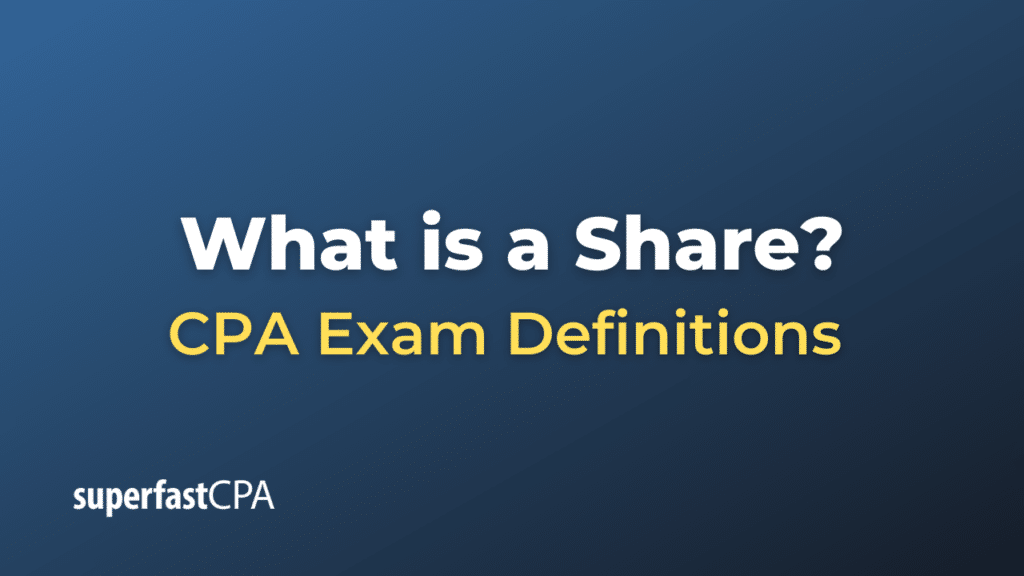Share
A “share” refers to a unit of ownership in a company or financial asset. It represents a fraction of the company’s capital and entitles the holder (often referred to as a “shareholder” or “stockholder”) to a portion of the company’s assets and earnings. Here are some key points to understand about shares:
- Equity Ownership: Owning shares in a company means you own a part of that company, albeit typically a very small part. Your ownership percentage is determined by the number of shares you own relative to the total number of outstanding shares.
- Dividends: Shareholders often receive dividends, which are portions of the company’s earnings distributed to its owners. The frequency and amount of dividends can vary, and not all companies pay them.
- Voting Rights: Many shares come with voting rights, meaning shareholders can vote on certain company decisions, typically at annual general meetings. The number of votes a shareholder has is usually proportional to the number of shares they own. However, some companies offer shares without voting rights or with different classes of voting rights.
- Capital Appreciation: Shares can increase or decrease in value based on the company’s performance and broader economic factors. Shareholders can potentially earn a profit by selling shares at a higher price than they purchased them.
- Types of Shares:
- Common Shares (or Common Stock): These are standard shares that entitle the holder to dividends (if any are paid) and voting rights.
- Preferred Shares (or Preferred Stock): These shares have a higher claim on dividends and assets than common shares. Preferred shareholders typically receive dividends before common shareholders and have a prioritized claim on assets if the company is liquidated. However, they might not have the same voting rights as common shareholders.
- Liquidity : Shares of companies that are publicly traded on stock exchanges can usually be easily bought and sold, making them liquid assets. However, shares in private companies are not as easily traded.
- Risk: Investing in shares carries risk. While there’s the potential for profit, the value of shares can go down as well as up, based on company performance, industry dynamics, economic factors, and other considerations.
In essence, a share is a stake in a company. By purchasing shares, you’re betting on the success and future growth of that company. The more shares you own, the larger the portion of the company you own, and the more influence you might have over its operations and decisions.
Example of a Share
Let’s use a fictional example involving the purchase of shares in a publicly traded company to illustrate the concept.
Example:
Jane has been following the technology industry closely and is particularly interested in TechGiant Corp, a company that specializes in innovative smart home products. After conducting her research and based on her belief that TechGiant’s upcoming products will be a hit, she decides to buy shares in the company.
- Purchasing Shares:
- On January 1st, Jane buys 100 shares of TechGiant Corp at $50 per share, spending a total of $5,000.
- Ownership:
- TechGiant Corp has 1 million shares outstanding. With her 100 shares, Jane owns 0.01% of the company. This is a tiny fraction, but she’s now a shareholder.
- Dividends:
- Voting Rights:
- TechGiant Corp holds its annual general meeting in July. As a shareholder, Jane gets to vote on certain matters, such as the election of board members. Her voting power is proportional to the number of shares she holds.
- Capital Appreciation:
- Due to the company’s success, by December 1st, the share price of TechGiant Corp has risen to $65 per share.
- If Jane decides to sell her shares at this price, she would receive $6,500 (100 shares x $65) – a profit of $1,500 from her initial investment, not including her dividends.
- Risk:
- Suppose TechGiant Corp had faced stiff competition, and its products weren’t as successful. The share price might have dropped instead of rising. If the share price had fallen to $40 and Jane decided to sell, she would’ve incurred a loss on her investment.
This example illustrates the potential benefits of share ownership, such as dividends and capital appreciation, but also emphasizes the inherent risks of the stock market. Jane’s decision to invest was based on her research and belief in the company’s future success, a crucial aspect of stock market investing.













